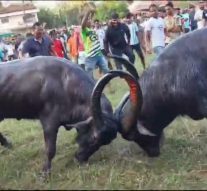Goa is abuzz with excitement as vintage bike and car owners, users, collectors and fans are decking […]

HIGH COURT CLAMPS DOWN ON BULLFIGHTS IN GOA! By Dr Olav Albuquerque
Aug 23- Aug 29, 2025, LAW August 22, 2025THE High Court has granted the Goa government four weeks to file its affidavit in a contempt of court petition concerning bullfighting, known popularly as dhirio in the state. The petition alleges the government failed to comply with a High Court order dated December 20, 1996 which had directed authorities to take immediate steps to ban all forms of animal fights, including bullfighting.
The court has now asked for the precise steps the government took through the Goa Police to curb the illegal practice, with the government required to submit its affidavit within the stipulated timeframe.
However, the issue is not as simple as it appears to be. During a discussion in the state Assembly some time back, legislators across party lines demanded bullfighting be legalized in Goa. The MLAs said that bull fighting, locally referred to as dhirio or dhiri, is an integral part of Goa’s cultural fabric. Never mind the cruelty to these hapless bulls some of whom may be gored to death.
In her book Goa, Cradle of My Dreams (1988), Nora Secco de Souza described Goan bull fighting as a “less complicated” and “less colourful affair” than its Spanish counterpart, for there are no flamboyant matadors who risk their lives wearing colourful capes to goad these maddened bulls to charge at the matadors. Goan bullfights have traditionally been held in paddy fields and football grounds of Goa, with village shepherds bringing in their animals.
CHURCH FEST EVENT
DHIRIO was a “part and parcel of every church fest” and villagers from miles around would gather to witness the popular sport in which “two thorough-bred bulls fight each other.” The massive bulls are bred and trained to fight and well, occasionally lose an eye, a horn or get mutilated in the process as the maddened and blood thirsty spectators goad them to fight till the death.
A bull fight begins with two bulls charging at each other and locking horns. They head-butt each other and repeatedly charge and retreat, provoked by trainers standing behind. The bull that gets pushed out of the arena first or turns and runs away loses the fight, unlike in Spain, where the animal has to die for the fight to end. A fight can be over in a few minutes or stretch for more than an hour, depending on which bull gives way to its opponent.
“It is a straight fight till one bull falls or flees. Often a bull is seriously injured,” said one bull owner who was previously involved in the practice. Bulls can even be gored to death at times. Agitated bulls may also charge at spectators, causing grievous injuries.
BULL fights have been taking place in Goa for generations, going back to the time of the Portuguese, former Nuvem MLA Radharao Gracias explained to the media. The economy was largely agrarian in those days. So, it was a custom to organise such fights after the harvest season. It was a form of entertainment. People would discuss the fights for days,” he said.
MIKE, TYSON,
RAMBO
THE bulls often had names such as (Mike) Tyson and Rambo (the famous Sylvester Stallone character), and had a devoted fan following. In those days, Taleigao, near Panaji, hosted the biggest annual bullfight after the harvest feast on August 21, drawing more than 5,000 spectators. Several dignitaries and politicians would patronise these fights with money.
“There was a coconut breaking competition and a bullfight. But in September 1996, Xavier Fernandes from Cana-Benaulim was killed by a “violent” bull at a fight organised at Ambaji-Fatorda. After the incident, the NGO People for Animals filed a petition in the High Court of Bombay at Goa, contending that bullfights were occurring illegally in contravention of the provisions of the Prevention of Cruelty to Animals Act, 1960.
Indeed, animals do not have fundamental rights unlike human beings in the Constitution. But laws like the Prevention of Cruelty to Animals Act, 1960 prohibits undue cruelty to animals in the name of sport. The High Court declared bullfights to be illegal and said they “cannot be permitted to be organised”. The Court directed the government to ban all animal fights, including bull fights and “dhirios” in the state of Goa. It is no exaggeration to say that some owners of bulls put chilli powder in the anus of their animals and beat them with pointed sticks to rouse them to fury so they will attack their opponents. This is cruelty without comparison.
BUT as some stalwarts in the Goa Police say, courts continue to impose bans which are ignored by the Goa Police. Bullfights, like matka betting, continue clandestinely in the coastal villages of Benaulim, Colva, Fatorda and Betalbatim in south Goa and throughout the coastal belt in north Goa. To evade police action, a fight’s location was shared on select WhatsApp and Facebook groups only a few hours before it was staged.
Now, they are popular for betting. The ban is only in the books. The Goan diaspora in Europe too places bets on fights on WhatsApp groups. In 2021, a contempt petition was filed in the High Court, alleging that bullfights were taking place despite orders of the court. In April this year, a bull died during a bullfight in a paddy field in Betalbatim. In January, a spectator was gored to death at bull fight near Benaulim.
SPORT OF GOA
TILL June 30, police had registered six cases under the Prevention of Cruelty to Animals Act for organising bull fights. But MLAs and bullfight organizers argued that bullfights were a traditional “sport of Goa.” There is no cruelty. It is a sport where the strength of bulls is put to test. It is like boxing. It can be regulated. The horns of bulls can be capped, but a ban goes against the tradition,” said some lovers of this horrible sport.
“If dhirio is legislated, it can be a tourist attraction. It can be a good source of revenue for tourism and for farmers who raise such bulls,” former Goa Chief Minister Laxmikant Parsekar announced in 2015. At the time, a House committee was also formed to examine the issue.
Although the sport is revolting to animal lovers, those Goans who are blood thirsty will continue to organize such bullfights to earn money from torturing their bulls. That is part of Goemkarponn.















